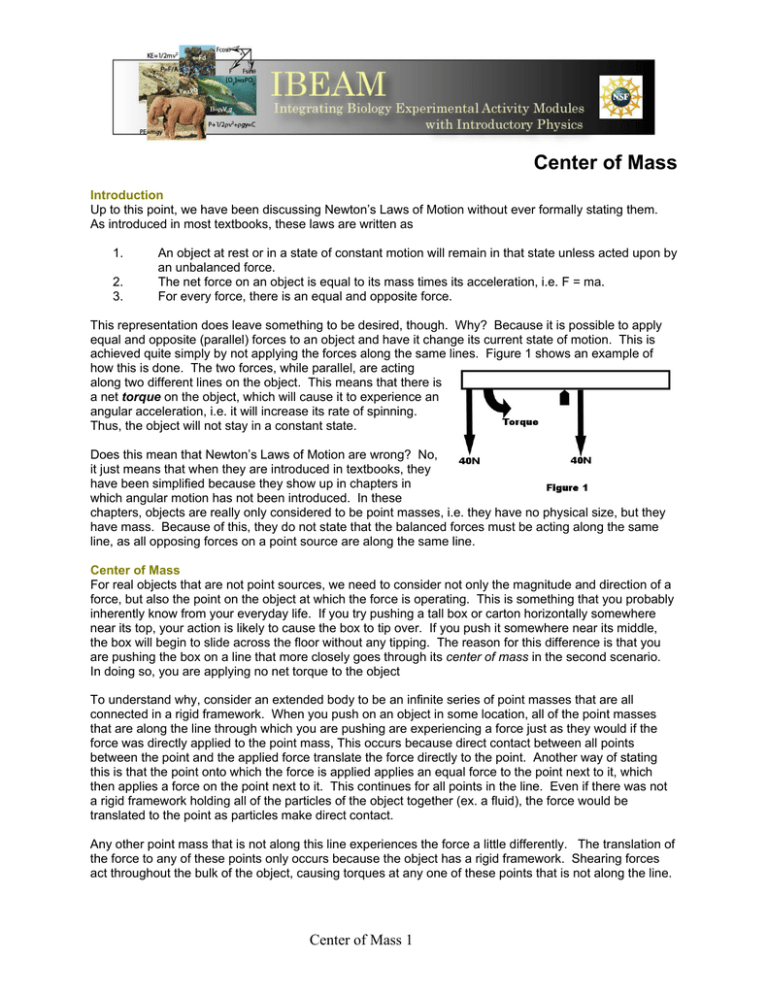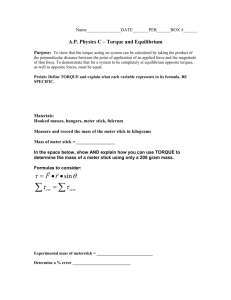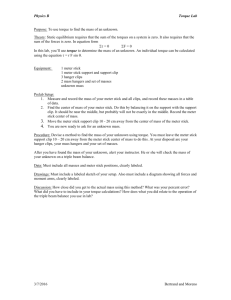Center of Mass - Clayton State University
advertisement

Center of Mass Introduction Up to this point, we have been discussing Newton’s Laws of Motion without ever formally stating them. As introduced in most textbooks, these laws are written as 1. 2. 3. An object at rest or in a state of constant motion will remain in that state unless acted upon by an unbalanced force. The net force on an object is equal to its mass times its acceleration, i.e. F = ma. For every force, there is an equal and opposite force. This representation does leave something to be desired, though. Why? Because it is possible to apply equal and opposite (parallel) forces to an object and have it change its current state of motion. This is achieved quite simply by not applying the forces along the same lines. Figure 1 shows an example of how this is done. The two forces, while parallel, are acting along two different lines on the object. This means that there is a net torque on the object, which will cause it to experience an angular acceleration, i.e. it will increase its rate of spinning. Thus, the object will not stay in a constant state. Does this mean that Newton’s Laws of Motion are wrong? No, it just means that when they are introduced in textbooks, they have been simplified because they show up in chapters in which angular motion has not been introduced. In these chapters, objects are really only considered to be point masses, i.e. they have no physical size, but they have mass. Because of this, they do not state that the balanced forces must be acting along the same line, as all opposing forces on a point source are along the same line. Center of Mass For real objects that are not point sources, we need to consider not only the magnitude and direction of a force, but also the point on the object at which the force is operating. This is something that you probably inherently know from your everyday life. If you try pushing a tall box or carton horizontally somewhere near its top, your action is likely to cause the box to tip over. If you push it somewhere near its middle, the box will begin to slide across the floor without any tipping. The reason for this difference is that you are pushing the box on a line that more closely goes through its center of mass in the second scenario. In doing so, you are applying no net torque to the object To understand why, consider an extended body to be an infinite series of point masses that are all connected in a rigid framework. When you push on an object in some location, all of the point masses that are along the line through which you are pushing are experiencing a force just as they would if the force was directly applied to the point mass, This occurs because direct contact between all points between the point and the applied force translate the force directly to the point. Another way of stating this is that the point onto which the force is applied applies an equal force to the point next to it, which then applies a force on the point next to it. This continues for all points in the line. Even if there was not a rigid framework holding all of the particles of the object together (ex. a fluid), the force would be translated to the point as particles make direct contact. Any other point mass that is not along this line experiences the force a little differently. The translation of the force to any of these points only occurs because the object has a rigid framework. Shearing forces act throughout the bulk of the object, causing torques at any one of these points that is not along the line. Center of Mass 1 The greater the distance between a mass point and the line, the greater the torque that will be experienced due to the force. If the line happens to include the center of mass of the object, then the net torque on the object due to the force will be zero. The reason for this has to do with the definition of the center of mass, which is calculated by summing the product of the distance that the point is from the line and the mass of the point, i.e. X COM ∝ ∑ xi mi i where xi is the distance from the line to the point and mi is the mass of the point. Because of this definition, for every mass point on one side of the line, there is a mass point on the other side of the line that will provide an equal and opposite torque to the first point. Since these equal and opposite torques pair up in this fashion, there will be no net torque on the object if the force lines up with the center of mass. Biological Systems This absence of a net torque when the net force lines up with the center of mass is very important in physical systems. Consider, for instance, the act of standing. Gravity is acting on every atom in your body while you are standing, pulling it toward the ground. If you had no rigid support structure, i.e. you were a liquid, your body would slump to the ground and spread out into a puddle. Luckily, your skeletal system and muscles provide a rigid framework that prevents this from happening. However, this rigid framework must be able to support the torques that are inherent in your body because you are an extended object and not a point mass. When you stand up straight with your arms down alongside your body, your center of mass is at a height near your midsection and is along a line that falls somewhere between your feet. Any torque from mass on one side of the center of mass is offset by an equal torque from some mass that is on the other side of your center of mass since the acceleration due to gravity is approximately constant across a region the size of your body. These torques all cancel, which gives the net effect of gravity acting on a point mass equal to your mass that is at the center of mass location. Because of this, the center of mass is often called the center of gravity. Since this center of mass/gravity lies over your feet, you do not experience any torque that pulls you over. If you raise your arm or leg so that it is sticking out horizontal to the ground, this situation might change. The change in the position of the arm or leg changes the location of the center of mass of the whole body, making it move away from the center of you midsection in the direction of the arm or leg. If the move is great enough such that it is no longer over your support structure, i.e. feet, then there will be a net torque on your body, and you will begin to fall over. This is the reason why other parts of your body naturally shift position in the opposite direction in order to keep the center of mass over your feet. For example, as you raise your leg in the air in front of you, you will note that your rear end will begin to move backward to achieve a more stable position. This distribution of torques along a moving body plays an especially important role in bounding evolution of biological systems. Take, for example, the giraffe in Figure 2. Almost 1/3 of the animal’s mass is extended along the neck. When it moves its head the center of mass shifts dramatically and the animal must have Center of Mass 2 the anatomical (and physiological) capacity to handle that. Many features of this animal have evolved as compensations for that center of mass shift including skeletal elements and muscular positioning. Imagine the dramatic change that occurs in the center of mass when the animal simply takes a drink! Activity In this week’s activity, we are going to study the center of mass of a very simple system: a meter stick with masses hanging on it. The equipment for performing this study is commercially available and consists of a meter stick, several knife-edge mass holders, masses, and a central pivot that supports the knife-edge holders (See Fig. 3). Its operation is quite simple: if the central holder that rests on the pivot is positioned at the center of mass of the system, then system will be balanced and the stick will remain horizontal when Fig. 3: Meter stick balance it is released; if it is not at the center of mass, then the stick will be skewed from the horizontal. Placing the masses at different locations along the meter stick will change the center of mass of the stick-mass system. By moving the central holder and testing for balance, one can find the new center of mass of the system and tests whether it agrees with the theoretical value, which can be found using the equation X system = M stick X stick + ∑ mi xi M stick + ∑ mi Where Mstick is the mass of the meter stick, Xstick is the center of mass of the meter stick, mi is the mass of one of the hanging mass and xi is the corresponding position of the hanging mass. Follow the procedure below, recording your answers on the attached activity sheet. Answer the questions once you are done. 1. Place the meter stick on the electronic mass scale and measure its mass. Record this on the activity sheet. 2. Slide a knife edge holder that has had its hanging clip removed on the meter stick and place it on the support. Move the holder along the meter stick until it remains horizontal when released. The position of the holder is the center of mass of the meter stick. Record this value. 3. Place two knife edge mass holders (with hanging clips) on the meter stick at the positions specified on the activity sheet for run number 1. Place the appropriate masses on each one, and then place the meter stick on the support using the central holder that does not have a hanging clip. Move the central holder until the stick rests horizontally. Record this new center of mass. 4. Repeat step 3 for the four other runs. 5. Calculate the theoretical center of masses for each system using the formula above. 6. Answer the questions on the activity sheet. Center of Mass 3 Name: Instructor: Mass of meter stick = __________ gm Center of mass of meter stick = _____________ cm Data No. M1 X1 M2 X2 1 50 gm 20 cm 100 gm 80 cm 2 50 gm 20 cm 100 gm 40 cm 3 50 gm 10 cm 50 gm 70 cm 4 100 gm 25 cm 50 gm 75 cm 5 100 gm 10 cm 50 gm 70 cm COMmeas COMtheory % Difference 1. How close is your calculated center of mass to the measured one? 2. What are the possible sources of random errors in this experiment? How have you attempted to account for them? 3. What are the possible sources of systematic errors in this experiment? Are their effects noticeable? If so, is the error large? Center of Mass 4



